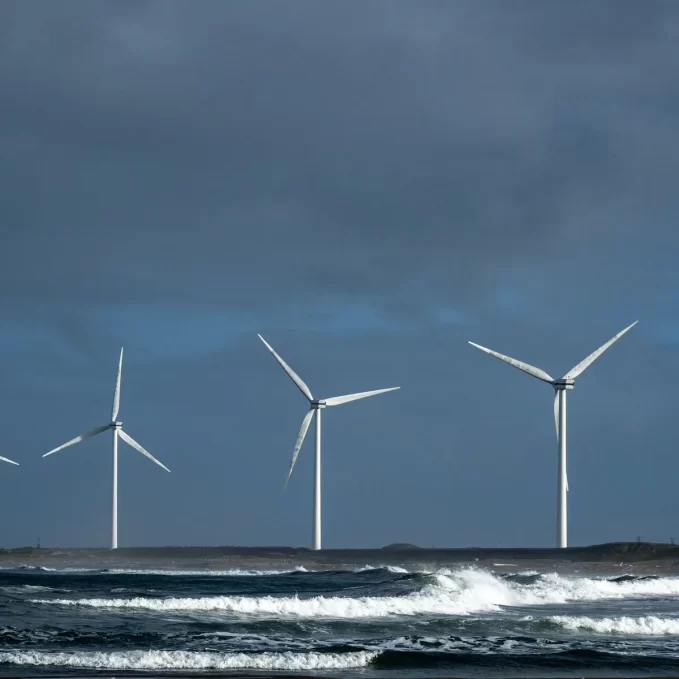
The potential for harnessing wind energy in the vast expanse of North America’s Great Lakes has long been recognized. With a surface water area larger than the entire United Kingdom, these lakes hold a remarkable capacity for offshore wind power. The US Department of Energy estimates a staggering potential of 700 gigawatts of offshore electricity, sufficient to energize millions of households. Despite this promise, previous projects and proposals have faced challenges that prevented their realization—until now.
Enter the Lake Erie Energy Development Corporation (Leedco), poised to transform the energy landscape with the Icebreaker wind farm. This groundbreaking initiative plans to generate 20 megawatts of electricity through six turbines situated several miles off the coast of Cleveland. While seemingly modest, this venture is North America’s maiden foray into freshwater offshore wind power. Construction is slated to commence by 2025, with electricity production starting two years thereafter.
Icebreaker holds the potential to revolutionize the energy scenario for the Great Lakes communities—a region comprising approximately 34 million people that has traditionally relied heavily on fracked natural gas and oil. Leedco envisions this project as a precursor to larger undertakings, potentially providing up to 5,000 megawatts of electricity in the future.
The shift towards electrification is imperative to prevent economic stagnation, according to Jade Davis of the Port of Cleveland. In an ever-evolving technological landscape, regions that embrace change stand to benefit economically, unlike those that resist progress.
The vast potential of the Great Lakes for offshore wind energy is evident. The neighboring state of Michigan boasts a coastline that stretches 3,288 miles, equivalent to the distance between London and Dubai. Yet, despite these abundant coastal resources, reliance on oil and natural gas continues to dominate energy consumption. Similar scenarios are observed in Wisconsin and Ohio, where coal and gas still constitute significant portions of electricity generation.
The momentum for change is palpable, with a third of Icebreaker’s projected power already committed to local governments. The need to bolster the region’s power infrastructure is evident, considering the influx of companies attracted by the abundant water resources and stable climate.
However, concerns about potential environmental consequences loom large. Wildlife enthusiasts are wary of the impact on bald eagles and other birds that frequent Lake Erie’s shores. A petition opposing the project has garnered over 9,000 signatures, reflecting concerns about the disturbance to the ecosystem.
One key concern revolves around the lubricating oil used within the turbines, which could potentially leak into Lake Erie. The project’s opponents fear the exacerbation of environmental issues, including the release of toxic sediment dredged from the polluted Cuyahoga River decades ago.
In response, project proponents emphasize the rigorous environmental assessment undertaken. Monitors have concluded that Icebreaker’s construction will cause minimal lakebed disruption, and any agitation would occur away from areas with potentially hazardous sediment.
Ed Verhamme, senior engineer at LimnoTech, an environmental consultancy, clarifies that the proposed project location is far from critical lake ecosystems. He underscores the absence of oxygen and spawning grounds in the region, minimizing potential disruptions.
While debates continue, the Icebreaker wind farm offers potential benefits. Its predicted creation of 500 jobs and commitments to environmental monitoring during construction are noteworthy. Additionally, the project could benefit local chartered fishing industries, as submerged turbine bases might create hubs of aquatic life.
The Icebreaker wind farm stands as a pioneering effort, a demonstration project that could pave the way for future expansions. Davis emphasizes that further large-scale projects would follow the same regulatory and environmental protocols.
In the quest for sustainable energy, the Icebreaker wind farm showcases both promise and caution. The delicate balance between energy needs, economic growth, and environmental conservation underscores the complexity of transitioning to renewable sources. As the Icebreaker project navigates the regulatory waters, it symbolizes the broader journey towards cleaner, more sustainable energy solutions for a changing world.










Leave a Reply